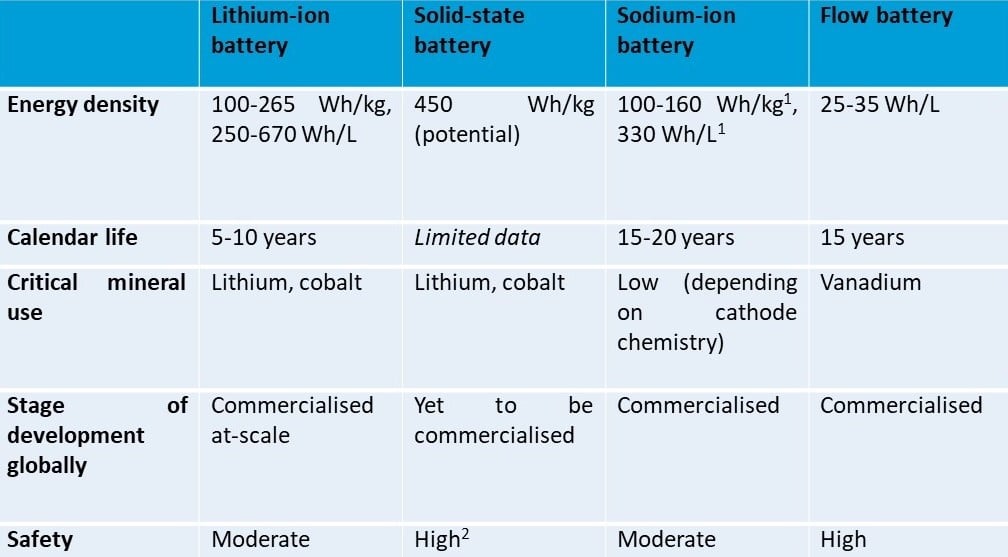Context
The demand for lithium-ion batteries (LIBs) has surged in recent years. This growth has been driven by cost reductions and technological improvements. Despite its benefits, there are concerns about LIBs’ energy density and cycle life, safety, resource-intensive manufacturing, and cost.
Several technologies, such as sodium-ion, solid-state, and flow batteries are already in various stages of deployment and development. However, cost parity should not be the only metric and other parameters must also be evaluated before choosing a technology for any use case. Some of the key parameters are mentioned below:
1. Energy and power density (particularly for mobility applications)
2. Shelf life
3. Levelised cost for the use case
4. Technology readiness level (TRL) or maturity
5. Safety in different use conditions
6. Existing manufacturing capacity
7. Recyclability
Further, we need to consider the environmental impact of these technologies, including the greenhouse gas (GHG) emissions produced during manufacturing and installation, as well as the waste generated at the end-of-life stage. With these considerations in mind, this note shares details on key battery storage technologies.
Solid-state battery (SSB):
Solid-state batteries in general refer to batteries in which the liquid electrolyte is replaced by a thin solid electrolyte. In SSBs, the low-energy-density electrode of a LIB can be replaced with lithium metal, greatly increasing the energy density of the battery. SSBs also minimise the formation of dendrites and could be much safer than current LIBs. These properties make them a front-runner to replace LIBs in some mobility applications. Despite this, breakthroughs in mass manufacturing and material stability are needed to mainstream SSBs.
Sodium-ion battery (SIB):
Sodium-ion batteries have been under development since the 1980s. SIB batteries are similar to LIBs in structure and the manufacturing process, except that the charge-carrier ion used in SSB is sodium rather than lithium. This difference entails changes in the chemistry of the electrolyte and anode used. SIB manufacturing has been commercialised for electric mobility and grid storage applications. They could greatly reduce the need for expensive critical minerals in battery manufacturing and reduce the chance of fires, compared to LIBs. There are challenges to be addressed with regards to their energy density and cycle life, but, even so, SIBs are a significant competitor to LIBs in the near term in low-cost electric vehicles and certain energy storage use cases.
Flow battery:
Flow batteries present a commercially viable alternative for long-duration energy storage needs. They store catholyte and anolyte solutions in separate tanks and charge/discharge by pumping these solutions through a central stack containing an ion-selective membrane. In many flow batteries, such as redox flow batteries, power and energy can be scaled independently of each other. This allows developers to increase the duration of energy storage cheaply by scaling up the electrolyte tanks without increasing the size of the more-expensive central stack.
Relevance and Impact
Internationally, several novel alternatives to lithium-ion are at various advanced stages of deployment. In India, many are still at the proof-of-concept stage. Given that we have already seen the potential of these technologies in India, it is crucial to accelerate the speed of domestic deployment.
Table 1: Comparing key energy storage technologies

Source: CEEW-CEF compilation from multiple sources
Note:
1. Energy density for cell;
2. Solid-state batteries are designed specifically to reduce the risks posed by the use of lithium metal in ordinary lithium-ion batteries
Who should care?
- Policymakers
- Tech financiers
- Battery manufacturers
- OEMs and developers
References
- [1] Clean Energy Institute (University of Washington). n.d. What is a lithium-ion battery and how does it work? Accessed January 24, 2022.
- [2] Clean Energy Institute (University of Washington). n.d. What is a lithium-ion battery and how does it work? Accessed January 24, 2022.
- [3] IEA. 2021. The Role of Critical Minerals in the Clean Energy Transition. Special Report, Paris: International Energy Association. Accessed January 24, 2022. https://www.iea.org/reports/the-role-of-critical-minerals-in-clean-energy-transitions.
- [4] Keen, Kip. 2020. As battery costs plummet, lithium-ion innovation hits limits, experts say. 14 May. Accessed January 24, 2022. https://www.spglobal.com/marketintelligence/en/news-insights/latest-news-headlines/as-battery-costs-plummet-lithium-ion-innovation-hits-limits-experts-say-58613238.
- [5] Persun, Terry. 2021. Advancing Battery Technology for Modern Innovations. 18 May. Accessed January 24, 2022. https://www.asme.org/topics-resources/content/advancing-battery-technology-for-modern-innovations.
- [6] Vousden, Mike. 2021. How far away are mass-market solid-state EV batteries? 7 December. Accessed January 24, 2022. https://www.just-auto.com/features/how-far-away-are-mass-market-solid-state-ev-batteries/
- [7] Hwang, Jang-Yeon, Seung-Taek Myung, and Yang-Kook Sun. 2017. “Sodium-ion batteries: present and future.” Chemical Society Reviews 3529-3614.
- [8] CATL. 2021. CATL Unveils Its Latest Breakthrough Technology by Releasing Its First Generation of Sodium-ion Batteries. 29 July. Accessed January 24, 2022. https://www.catl.com/en/news/665.html.
- [9] Trivedi, Anjani. 2021. Why sodium-ion battery could be the next best electric car battery. 14 September. Accessed January 24, 2022. https://theprint.in/opinion/why-sodium-ion-battery-could-be-the-next-best-electric-car-battery/732982/.
- [10] Power Magazine. 2020. Flow Batteries: Energy Storage Option for a Variety of Uses. 2 March. Accessed January 24, 2022. https://www.powermag.com/flow-batteries-energy-storage-option-for-a-variety-of-uses/



